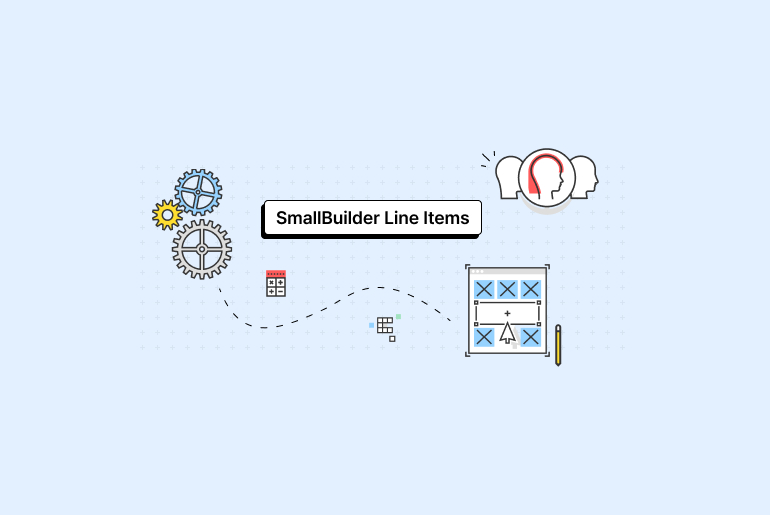Many businesses make use of line items in their Salesforce opportunities, quotes, service contracts, and other custom objects. Line items allow you to break down a product or service into its components for billing, reporting, or other purposes. This provides greater flexibility and detail compared to only working with total amounts.

For example, a maintenance service business can add individual line items for services due or performed, replacements parts on order, or warranty entitlements. This allows them to accurately track work to be done, provide detailed costs in quotes or invoices, and gain insights into their most profitable services. Line items enable tracking at a granular level to improve business operations.
Overall, line items are an important Salesforce feature that provides significant benefits to many businesses. However, they can be tricky to set up out-of-the-box.
Standard Line Item Options in Salesforce
Salesforce provides out-of-the-box (OOTB) line items for products on opportunities and quotes. When you add a product to an opportunity or quote, a corresponding line item is automatically created. This line item contains basic information like product name, quantity, unit price, discount, and total price.
However, the OOTB line items have some key limitations:
- They can only be used for products on opportunities and quotes – you can’t add them to other objects or record types.
- The fields available on OOTB line items are somewhat fixed – while you can create custom fields, you can’t merge external data.
- You have limited control over how line items are displayed and how prices or discounts are calculated.
- You can’t add further detail with add-ons or options for a product.
So while OOTB line items work for simple cases, they don’t provide the flexibility that many businesses need for custom processes or complex products and services.
Workarounds for Custom Line Items
Since Salesforce’s out-of-the-box line items don’t allow for full customization, businesses often resort to workarounds to try to add customized line items. There are two main options, each with significant challenges:
Via User Interface
Admins can try to customize line items directly in the Salesforce user interface, such as by adding formula fields and validation rules manually in the Setup menu. However, this doesn’t allow you to create new line items for any object you need, only to modify the interface slightly for existing OOTB line items. The Salesforce UI simply wasn’t designed for that level of customization. At best, admins can build a crude workaround, but it won’t have the flexibility or functionality needed for many businesses.
Custom Development, In-House or Via Consultancy
The other option is hiring developers or contracting a consultancy to build a fully customized line item view via Apex and Visualforce. This allows for the ultimate flexibility and customization. However, it requires skilled developers and is typically very expensive and time consuming. Not a feasible option for many businesses.
Introducing SmallBuilder Line-Items
SmallBuilder Line Items is an app on the Salesforce AppExchange that allows you to easily add custom line items to any object in Salesforce, without writing any code.
The key capabilities of SmallBuilder Line-Items include:
- Add line items to any standard or custom objects like Opportunities, Quotes, Work Orders, and more
- Configure line item fields, validation rules, formulas, and more without code
- Includes convenient CPQ-like features such as automatic discount calculation and custom product options out of the box
- Integrate external data into your line item view in real-time, like inventory numbers from an ERP system
With these capabilities, SmallBuilder Line-Items provides a flexible way to add customized line items to Salesforce objects without expensive and time-consuming development work.
Add Line Items to Any Object
One of the key benefits of SmallBuilder Line Items is the ability to add custom line items to any standard or custom object in Salesforce, with just a few clicks. This includes opportunities, quotes, orders, work orders, invoices, projects, and more.
For example, to add line items to opportunities, an admin simply needs to set up the configuration using the no-code interface provided in the app. Users can then easily add or edit line items directly on the opportunity screen. An example and explanation can be seen in this video:
The same process can be followed to connect line items to any other object like work orders and other custom objects. This flexibility allows you to track and report in detail whatever entity is relevant to your business, like service tickets, expense items, projects, research and more.
According to this Trailblazer community post, most businesses use custom objects extensively, so being able to add line items to custom objects is a huge benefit.
Powerful CPQ Capabilities
SmallBuilder Line Items includes powerful CPQ functionality to help streamline and customize your sales processes. Key capabilities include:
- Custom Discount Formulas – Easily create custom discount formulas, for example tiered volume discounts or account-specific negotiated discounts. Sales reps can then easily apply a discount in the opportunity screen and have the prices update automatically.
- Product Options – Allow sales reps to dynamically customize orders while they’re being booked, with options like size, color and add-ons reflected in the line item.
- Real-Time External Data Integration – Pull data like inventory availability, pricing, and components from outside systems directly into your quotes and orders. This unique capability keeps all the information sales reps need on the same page, making it faster and easier to look up information and complete quotes and orders.
These features allow endless flexibility in configuring and pricing complex products, while keeping the sales process contained within Salesforce. And it’s all handled through easy point-and-click configuration, no code required.
Simplified Administration
One of the key benefits of SmallBuilder Line Items is that it requires no code to set up and manage. As an administrator, you can configure the line items entirely through the user interface rather than needing developers and custom code.
This saves you time and money compared to custom development. And it also makes managing the line items much easier on an ongoing basis. When your business needs change, you can quickly update the configuration yourself without waiting on development resources and getting approval for the budget.
Use Cases
SmallBuilder Line Items can be used to streamline workflows across sales, service, operations, and more. Here are some examples of common use cases:
- For sales teams, SmallBuilder Line Items allows creating detailed quotes and orders. You can add custom options and discounts at the line item level for additional flexibility. Real-time external data integration ensures accurate inventory is displayed during the sales process. This helps sales reps configure quotes, validate stock levels, and set accurate delivery timelines.
- Used with service contracts, support agents can leverage line items to track issues and resolution details. Each case or work order can include multiple line items for tasks, parts, or time entries. Line item formulas can automatically calculate values like person-hours spent or cost. External data integration gives agents transparency into resource availability in real-time when scheduling services.
- For operations, SmallBuilder Line Items enables tracking detailed budgets, expenditures or operational tasks. For example, linking line items to projects or events to capture costs like materials, labor, venues, equipment rental, etc. Real-time calculations provide quicker, easier insights into spending and help prevent budget overruns.
The ability to add line items to any custom object makes the possibilities endless – from inventory management to manufacturing to HR and more. SmallBuilder Line Items provides the flexibility to track intricate details and pull in external data across all your key business processes in Salesforce, even in cases where that data must remain in another system.
Cost savings
In addition to the flexibility and power described above, using SmallBuilder Line Items can save your business money. In comparison to expensive and time-consuming custom development, SmallBuilder Line Items is free for up to 10 users and available from the security-vetted Salesforce AppExchange, so you can be confident that your sensitive data doesn’t leave your own Salesforce.
Conclusion
In summary, SmallBuilder Line Items provides sales, service and operations teams the flexibility to add customizable line items to any Salesforce object. This allows you to break down products, services, and other records into granular components for improved tracking, billing, and reporting.
The key benefits include:
- Add line items without code, only needing a simple admin setup
- Works with all Salesforce objects, including custom objects
- Supports custom fields, validation rules, formulas, and more
- Brings in external data via real-time integration
- Gives you CPQ capabilities like custom discounts and product options
With SmallBuilder Line Items, you can easily customize line items to streamline your workflows, without expensive custom development. It’s a valuable addition for organizations using Salesforce to manage complex sales and service processes.
SmallBuilder Line Items is free for up to ten users on the Salesforce AppExchange.



![[Feature] Multi-Column Sort in List View: See More, Sort Smarter](https://blog.smallbuilder.com/wp-content/uploads/2025/07/목록-보기-다중-열-정렬-더-많은-열로-보고-싶다면-370x245.jpg)
![[Feature] ✍️Signature Component – No More Paperwork: Sign Right On-Site ! Mobile Signature Featured Image](https://blog.smallbuilder.com/wp-content/uploads/2025/06/documetns-모바일-서명-기능-370x245.jpg)
![[Feature] 🔎Powerful Filtering: Utilizing Dependency Filters](https://blog.smallbuilder.com/wp-content/uploads/2025/02/MainImage-370x245.jpg)
![[Use Case] Easily Managing Detail Data in Master-Detail Relationship [Use Case] Master-Detail에서 Detail 데이터 쉽게 관리하기](https://blog.smallbuilder.com/wp-content/uploads/2025/02/Use-Case-Master-Detail에서-Detail-데이터-쉽게-관리하기-370x245.jpg)